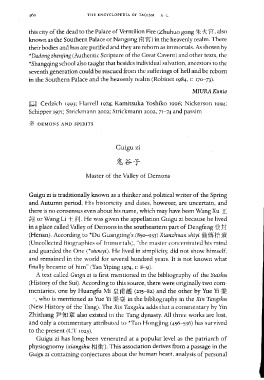Page 500 - The Encyclopedia of Taoism v1_A-L
P. 500
THE ENCYCLOPEDIA OF TAOISM A-L
this city of the dead to the Palace of Vermilion Fire (Zhuhuo gong * *- ',3 , also
known as the Southern Palace or Nangongi¥f-g) in the heavenly realm. There
their bodies and hun are purified and they are reborn as immortals. As shown by
*Dadong zhenjing (Authentic Scripture of the Great Cavern) and other texts, the
*Shangqing school also taught that besides individual salvation, ancestors to the
seventh generation could be rescued from the sufferings of hell and be reborn
in the Southern Palace and the heavenly realm (Robinet 1984, I: 170-73).
MIURAKunio
rn Cedzich 1993; Harrell 1974; Kamitsuka Yoshiko 1996; Nickerson 1994;
Schipper 1971; Strickmann 2002; Strickmann 2002, 71-74 and passim
* DEMONS AND SPIRITS
Guigu zi
Master of the Valley of Demons
Guigu zi is traditionally known as a thinker and political writer of the Spring
and Autumn period. His historicity and dates, however, are uncertain, and
there is no consensus even about his name, which may have been Wang Xu £
~~ or Wang Li _-f 1'1] . He was given the appellation Guigu zi because he lived
in a place called Valley of Demons in the southeastern part of Dengfeng ~><: it
(Henan). According to *Du Guangting's (850-933) Xianzhuan shiyi {w{~tif ji
(Uncollected Biographies of Immortals), "the master concentrated his mind
and guarded the One (* shouyi). He lived in simplicity, did not show himself,
and remained in the world for several hundred years. It is not known what
finally became of him" (Yan Yiping 1974, I: 8--9).
A text called Guigu zi is first mentioned in the bibliography of the Suishu
(History of the Sui). According to this source, there were originally two com-
mentaries, one by Huangfu Mi ~ ffitilllf (215-82) and the other by Yue Yi i;!Jl%
" who is mentioned as Yue Yi ~ ~ in the bibliography in the Xin Tangshu
(New History of the Tang). The Xin Tangshu adds that a commentary by Yin
Zhizhang ¥ j;Q lj[ also existed in the Tang dynasty. All three works are lost,
and only a commentary attributed to *Tao Hongjing (456-536) has survived
to the present (CT 1025).
Guigu zi has long been venerated at a popular level as the patriarch of
physiognomy (xiangshu f§ 1fi). This association derives from a passage in the
Guigu zi containing conjectures about the human heart, analysis of personal

